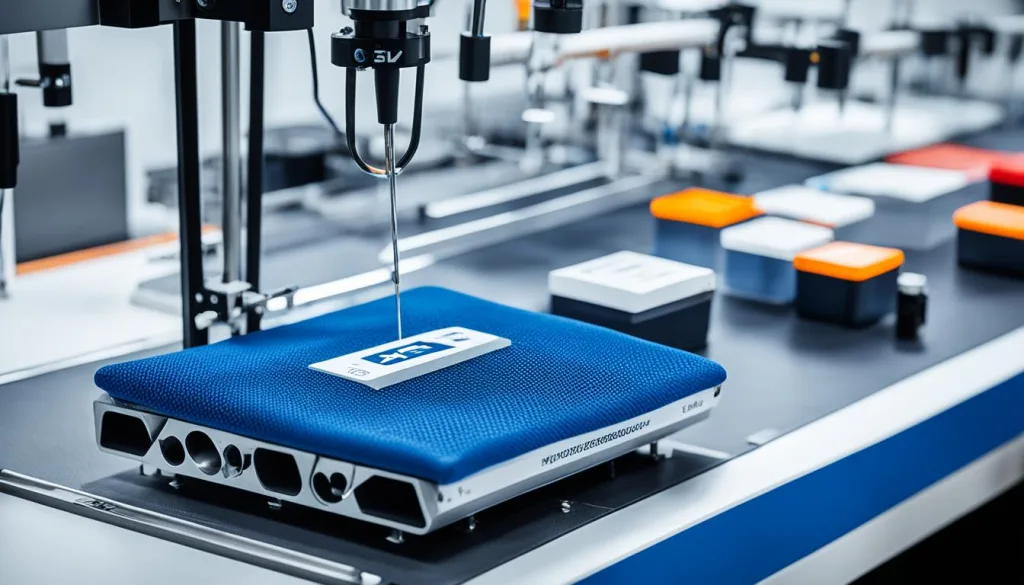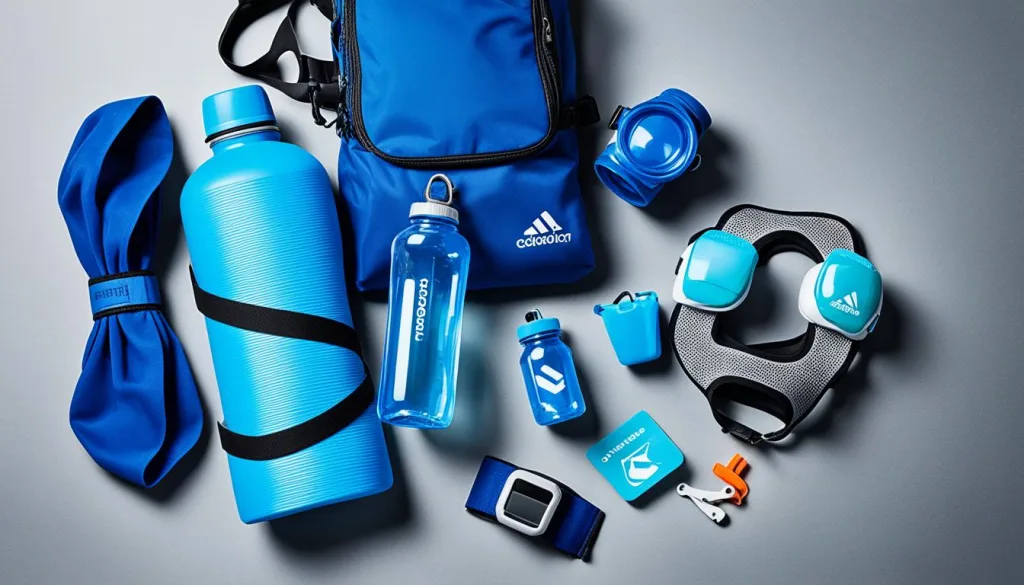Navigating the Compliance of Sportswear Accessories
Connect With Us Today
Consider us for your next production run. Why wait? Send us your questions here.
The sportswear market is changing fast, making it hard for companies to keep up with new rules. They need to understand the laws for sports gear, especially with recent changes like France’s EPR law for sports items. It’s vital to know these rules1.
Knowing all about the regulations helps companies earn trust. It shows they care about making safe, high-quality, and green products.
Key Takeaways
- Staying informed about global and national sportswear compliance guidelines is essential.
- Compliance impacts not just product design but also labeling, packaging, and disposal1.
- EPR legislation like France’s Triman mark requirement sets new standards for industry sustainability1.
- Anticipating and preparing for changes, such as the EU’s impending regulations, is crucial for a future-proof business strategy1.
- Organizations must consider the implications of safety regulations and reporting obligations, like those for PFAS substances1.
- Environmental and safety labeling, driven by European guidelines, will increasingly influence consumer choice and product life cycle management1.
Understanding the Global Regulatory Landscape for Sportswear Accessories
The sportswear industry’s global rules are complex. Companies aim to meet varying compliance rules worldwide. Understanding and following these rules is crucial, not just legally, but for strategic business growth. Makers need to know the guidelines on product safety, labeling, and quality. These are based on global standards. Being quick to adapt to these regulations ensures they can keep selling internationally and grow.
Impact of International Standards on Sportswear Compliance
International market trends, like China’s growing sportswear industry, highlight compliance’s role. In 2021, retail sales reached RMB371.8 billion (US$51.9 billion), making up 13.4 percent of the apparel market2. For growth to continue, following these standards is key. The expected CAGR above 9% by 2025 shows the potential for success if companies stick to the rules. The growth in sports accessories suggests a future market value over RMB 50 billion (US$6.9 billion) by 20252.
Brands like Nike, Adidas, and Anta have set the standard in the Chinese sportswear market for compliance2. Over half of sportswear brands’ ad budgets go to Douyin Ads. This shows how marketing and compliance strategies are merging to reach aware customers2.
Online platforms are reshaping the global regulatory landscape, as seen in India’s huge online shopping scene3. YES BANK and EBANX’s partnership shows how tech and compliance can work together. They aim to help global retailers enter India’s promising market3. This kind of collaboration shows a trend where rules meet tech innovation to improve customer experiences.
For global brands, compliance is crucial for lasting business success, not just a legal must-do. China’s plan to grow its sports economy to US$850 billion by 20252, and India’s push for digital progress shows how regulations and government policies mesh, affecting the sportswear market globally.
Key Sportswear Compliance Guidelines in the U.S. Market
The U.S. sportswear market is changing fast. It puts a lot of emphasis on following sportswear compliance rules. Everyone in the industry needs to keep up to make sure their products follow U.S. rules to stay ahead.

New safety rules for sports gear in the U.S., like Maine’s law against harmful substances in sportswear1, mean makers and importers have to be extra careful to follow these rules. The Federal Trade Commission is also looking more into claims about being eco-friendly, leading to a push for more honesty and product quality in the market1.
Labeling Regulations for Athletic Gear
All sports clothing must have clear and complete labels under the rules. Recent changes, like those in Fiber Names and Hang-tag info4, help trade and keep consumers informed. Labels have to be right about what the product is and also make true claims about being eco-friendly1.
Safety Standards for Sports Accessory Manufacturing
New rules are being set for safety and the environment, like the European Union’s stance on PFAS1. Manufacturers need to keep up with these new safety rules to affect the U.S. market. They must adapt their practices to meet these safety standards for sports gear.
Import Regulations for Sportswear Accoutrements
Keeping up with U.S. import rules for sportswear is crucial for importers. The product’s country of origin is defined by the last big change made to it4. E-commerce changes are making it easier to handle business online, helping with compliance while doing business digitally4.
Understanding the complex world of U.S. sportswear rules is a must. As we move towards more sustainable and responsible practices, following these guidelines is not just about following the law. It actually sets businesses apart in the competitive market.
Navigating the Compliance of Sportswear Accessories
For sportswear makers and sellers, ensuring compliance is crucial. It’s more than just following rules. Understanding compliance challenges affects both daily operations and brand image. Facing a complex navigating regulatory landscape means staying alert. This approach helps tackle regulatory hurdles effectively. Fans, students, and faculty linked with sports carry a lifelong label for compliance teams5.
Recruiting is vital for college sports teams. It comes with its unique problems. For example, knowing the rules about meetings and visits is essential. Any in-person meeting that goes beyond a hello counts as a contact. These must be carefully tracked to keep things legal5. There’s a balance between meeting goals and following the rules. An official visit has school funding, while an unofficial visit does not. Unofficial ones allow certain benefits5.
Furthermore, avoiding illegal bonuses—like cash, discounts, or gear—is key in sportswear compliance. Offering such perks threatens student-athletes’ amateur status. It can result in punishments and harm the school’s image5. Knowing and understanding these complex rules is essential.
| Compliance Area | Description | Implication for Sportswear |
|---|---|---|
| Representative of Athletics Interests | Includes fans, students, faculty, staff, and alumni | Long-standing affiliation and adherence required |
| Extra Benefits | Unpermissible incentives to athletes | Sportswear benefits restricted to ensure fairness |
| Recruiting | Transport and encounters with prospects | Logistics of sportswear provision during recruiting |
| Prospects | Individuals starting ninth grade or receiving benefits | Monitoring of sportswear influence from early stages |
| Contact | Face-to-face encounters beyond greetings | Regulated interactions regarding sportswear discussions |
| Visits | Official (institution-financed) and Unofficial | Provision of sportswear and transport during visits |
| Amateurism | Ban on benefits not available to general students | Equity in sportswear access among students |
The main aim for sportswear allies is navigating sportswear compliance actively and honestly. All actions and gifts should follow set rules to ensure fairness. This requires working together, clear talks, strong training, and a solid compliance plan5.

Impact of EPR on Sportswear Accessory Market Dynamics
The sportswear accessory market is seeing big changes due to Extended Producer Responsibility (EPR). This idea makes manufacturers, not consumers, responsible for their products at the end of their life. EPR is key for making sportswear more sustainable. In France, EPR is leading the way in making the industry focus on eco-friendly design, better product lifecycles, and smarter use of resources.
Studies show that products lasting just 1% longer could boost Europe’s economy by 7.9 billion EUR each year. This presents major economic, social, and environmental benefits for the EU6. This change pushes for growth that is smart, sustainable, and includes everyone. It helps strengthen the market and supports a shift towards better EPR in sportswear.
France’s Pioneering Extended Producer Responsibility (EPR) for Sportswear
France is setting an example with its EPR laws. It makes sure manufacturers consider the entire life of sportswear accessories. This highlights how crucial sustainability in sportswear is, affecting both how products are made and dealt with as waste. France’s rules are changing the market to value environmental impact as much as consumer demand and growth.
Implications of EU’s Proposed Harmonized EPR Schemes
The European Union is working on uniform EPR schemes for all member states7. This requires changing how things are produced and disposed of to meet new EPR rules. It aims to guide industries towards greener practices. These EU EPR plans could boost the economy, improve consumer protection, and cut down the sportswear industry’s environmental harm. It’s about making profit and sustainability work together, setting an example for the world.
FAQ
What are the compliance requirements for sportswear accessories?
Which international standards influence the compliance of sportswear accessories?
What are the specific compliance guidelines for sportswear accessories in the U.S. market?
How can companies navigate the compliance of sportswear accessories?
What is Extended Producer Responsibility (EPR) and how does it impact the sportswear accessory market?
What are the implications of the proposed harmonized EPR schemes in the EU for the sportswear accessory market?
Source Links
- https://www.complianceandrisks.com/blog/5-regulatory-issues-your-sporting-goods-company-cant-afford-to-overlook/
- https://www.china-briefing.com/news/chinas-sportswear-market-opportunities-and-challenges-for-foreign-players/
- https://www.prnewswire.com/apac/news-releases/yes-bank-and-ebanx-announce-strategic-partnership-to-empower-cross-border-commerce-in-india-302137550.html
- https://www.ftc.gov/business-guidance/resources/threading-your-way-through-labeling-requirements-under-textile-wool-acts
- https://floridagators.com/sports/2015/12/10/_compliance_p_definitions.aspx
- https://www.europarl.europa.eu/RegData/etudes/STUD/2016/579000/IPOL_STU(2016)579000_EN.pdf
- https://www.justice.gov/d9/atr/case-documents/attachments/2008/04/21/236561.pdf
Latest News
How Collaboration Shapes Consumer Preferences in Sportswear
Navigating Consumer Rights and Warranties in Sportswear Sales
Artificial Intelligence in Fashion Forecasting and Trend Analysis
The Shift Towards Inclusive Sizing in Sportswear: Consumer Reactions
The Global Expansion of Luxury Sportswear Brands
From Sketch to Gym: The Design Process of Fashionable Sportswear
Understanding the Role of Trade Associations in Sportswear Compliance
How Economic Trends Influence Consumer Spending on Sportswear
Learning from Successful Global Market Entries
Best Practices for Managing Cross-Cultural Teams
Using Technology to Fight Counterfeit Fashion Products
Carbon Nanotube Fabrics for Superior Strength and Flexibility
The Growth of Fitness Tracking Apparel in Health and Wellness
Exploring the Influence of Social Proof in Sportswear Purchasing
Strategies for Managing Compliance in a Multinational Operation
Trends in Global Footwear: Performance Meets Lifestyle
The Role of Artificial Intelligence in Tracking Supply Chain Operations
Evaluating the Success of Sportswear Collaborative Projects
Evaluating the Potential of Emerging Markets
Global Shifts Towards Gender-Neutral Sportswear
Share This Article
Latest Articles



















